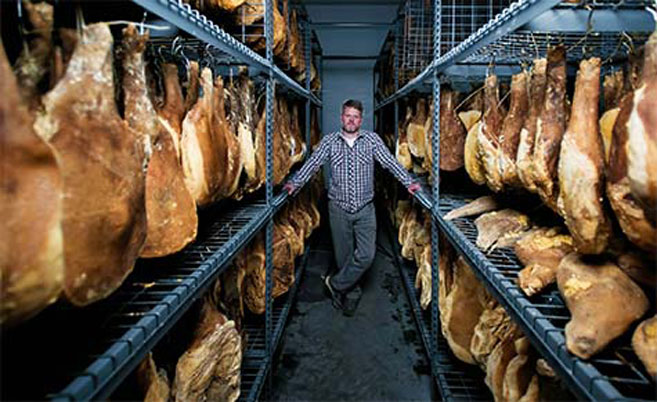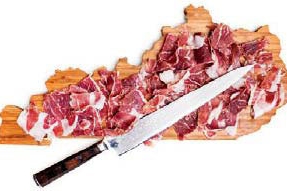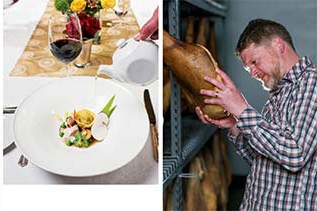A Different Kind of Cure: Woodlands Approach Yields Ham Without the Saltiness
Bosses often brag about their large offices, but it’s doubtful any has one as expansive as Jay Denham’s. As master charcutier for Woodlands Pork, Denham’s work space is a 40,000-squarefoot building in South Louisville.
Fully 85% of the former Furrow’s lumber store is empty, but near the center of the metal building is a pristine, climate-controlled curing room wherein hundreds of Mountain Hams, pork shoulders, bellies and backs hang and dry age for six to 36 months. Other than some occasional help from a part-time understudy, Denham is the lone worker here.
“This is it. This is where I work,” says Denham while inspecting rack after rack of aging hams, checking for firmness and sniffing out undesirable mold. Country music trickles into the room from a nearby radio, something he muses may effect positive changes in his hams. Adding with a smile, he says, “We know plants like music, so why not hams? I like it, so maybe I do a better job when I’m listening to it.”
The countless pig parts, harvested from heritage-breed hogs, make up some of America’s finest cured pork. Denham butchers and cures them in the European style (meaning they’re sectioned a bit differently than an American commodity hog) and then cured with salt only, no smoke. Despite humidifiers running constantly in the curing room, he uses a compressed-air sprayer to propel even more water mist into the room.
“Besides not smoking our hams, a big difference from the way country hams are cured and ours are cured is I’m working to keep moisture in the hams,” says the normally soft-spoken Denham, raising his voice over the hissing of the sprayer. He points to an ordinary weather gauge in the room that shows the humidity at 76%. “Most country ham makers try to get moisture out, which, to me, makes the product salty and dry. I want it to be as moist as possible while it ages.”
Aging any meat triggers enzymatic activity that produces robust flavors and tenderness. But unlike beef that’s dryaged to tenderize it, salt-curing meats is an ancient means of preserving animal flesh beyond harvest. And what for centuries in the American South was seen as sustenance food, cured meat like Woodlands’ is increasingly regarded by many as an indulgence worth its steep price.
“The market for cured hams is truly a high-end specialty market,” says Bob Perry, special projects manager for the Sustainable Agriculture and Food Systems Working Group at the University of Kentucky’s College of Agriculture in Lexington.
Ironically, any growing market demand, Perry adds, isn’t coming from the South, where country ham (defined as ham that’s dry cured with salt, sometimes sugar, and smoked) still maintains a foothold.
“As much as I love my home state, we’re pretty damn provincial and slow to change,” says Perry. “I don’t see a big market for it in Kentucky outside of a few great restaurants, but where cured hams are starting to gain steam are on the coasts in big restaurant cities.”
Much of that slow growth in the South is tied to the tradition of country ham and its going rate. Not only are older southerners not inclined to eat their cured ham sliced paper thin like a prosciutto, they’re not used to paying more than $60 for a whole 14-pound hindquarter.
By comparison, Woodlands’ Mountain Hams, sold only through distributors to finer restaurants, cost between $350 and $500, seven to 10 times the cost of a supermarket country ham made by Clifty Farm, the nation’s largest producer.
Perry predicts, national demand will change.
“Once people get a taste for this, they generally don’t go back,” he said, referring to the Mountain Ham. “The flavor is just so different, so unlike anything they’ve had before that they stop when they taste it.” “Only one bad day”
Pigs that become Woodlands Pork live sustainably in the fields of Black Oak Holler Farm in Mason County, West Virginia. The farm abuts the foothills of the Appalachian Mountain range, which is home to the world’s richest mast-producing forest. (Mast is the combination of nuts and fruits that fall from trees.)
There the hogs spend much of their year-long life grazing on barley, rape, corn, beans and squashes planted by the farm’s owner and hog geneticist, Chuck Talbott. Come the fall, they’re driven to the forest where they forage for pawpaws, hickory nuts, acorns, grubs, roots and beechnuts. That diverse diet forms the foundation for the incredible flavor in Denham’s Mountain Hams, most of which is found in its fat. “We raise our pigs for their fat because that’s what gives them their flavor, their value,” Denham says.
Their free-range raising helps develop good muscles as well.
“As we like to say, ‘Those pigs only have one bad day,’” says Perry. “A lot of small farmers trying to raise heritage breeds are trying to practice good husbandry like this, but they really don’t know what it means. Chuck [Talbott] really does.”
Perry met Talbott in 2006 after reading an article in a technical journal about sustainable production of heritage-breed hogs. Talbott invited him to Black Oak Holler Farm and let him taste what he’d written about.
“That first taste of pork loin from a pig that was acorn finished was mind-expanding,” Perry recalls. “The richness of that meat, that fat, like nothing I’d had.” A chef by trade, Perry later met Denham, then executive chef at Park Place and Browning’s restaurants in Louisville. There Denham made various salume for the restaurant, which led Perry to introduce Denham to Talbott and his business partner, Nicholas Heckett, Clifton, Virginia– based businessman with a passion to find the perfect cured ham. As the men began brainstorming on how to create a worldclass American cured ham, Park Place and Browning’s closed, freeing Denham to follow his dream of learning butchering and curing in Italy.
For eight months, he learned to slaughter, butcher and cure pork from masters of the art, including Massimo Spigaroli, a chef and renowned charcutier in Zibello, Emiglia Romana, Italy. Denham’s pay was room and board only at the historic Antica Corte Pallvacinia castle.
Upon returning to Louisville, he set out to butcher and cure the meat from Talbott’s cross-bred herd of Ossabaw and Mulefoot sows mated with wild Russian boars captured on the farm. Not having an approved USDA curing facility, Denham had to truck the hogs from West Virginia to various processors in central Kentucky, and then have them cured at Broadbent’s B&B Foods in Kuttawa, Kentucky. In 2012, Woodlands bought the aging facility in Louisville.
Near the same time, Bob Hancock, co-owner of Blue Dog Bakery in Louisville, began serving some of his own cured salume, including hams made from his herd of Red Wattle hogs raised in Goshen, Kentucky. He featured the paper-thin cuts on special Thursday meals dubbed Red Hog Tapas nights. The events were so successful Hancock couldn’t keep pace with demand, so he stopped the events until he could expand his herd. This year he and wife Kit Garret will instead open Red Hog, a combination restaurant and butcher shop featuring fresh and cured meats in Louisville’s Crescent Hill neighborhood.
“It’s a good time to do this because people are slowly discovering good charcuterie for its flavor,” Hancock said last February during a get-together at Denham’s house.
“What they also appreciate now is the craft that goes into it. People know it takes time to do this right if it’s going to be done naturally.”
Barry Yates, corporate chef at Winston Industries in Louisville, is a fan of both men’s hams, and said his travels across the globe place him in front of many a salume platter. What Denham and Hancock are doing, he adds, is common in Europe, but only now taking off in the U.S. Many hobby curers want to do their own salume, he adds, but the highest expression of this revived culinary art takes serious work.
“Like what Jay is doing: That’s a matter of the education about the processes, the terroir, how those pigs are raised, their feeding, raising, their blood stock, the whole curing process — he’s invested in himself to learn all of that,” says Yates, whose company manufactures CVap ovens and Colletramatic pressure fryers.
“Anybody can cure a ham, but it’s a matter of knowing what you’re looking for and watching the product as it matures. Having that depth of knowledge shows his commitment to a craft.”
Patrick Roney, chef de cuisine at The Oakroom at the Seelbach Hotel, has served whole dinners centered on Woodlands Pork products, including its Back Bacon and coppa (a combined neck and shoulder cut). Their powerful flavors require only small portions of the meat to make a statement, he says.
“The depth of flavor and the texture are as good as on any ham I’ve ever eaten,” says Roney. “Sometimes cured hams are just too salty — that’s the only flavor you get — but his aren’t. What they fed those pigs and how he’s aged them, those are the flavors that really come through.
Steve Coomes is a former chef and freelance writer in Louisville.







